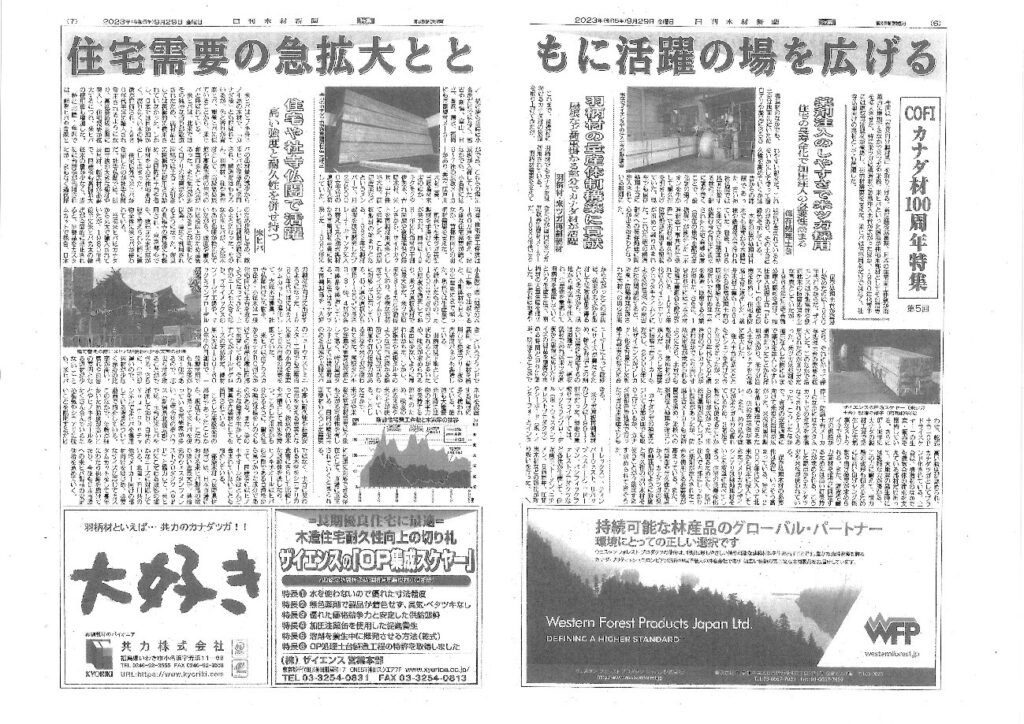Celebrating 100 Years of Wood Trade between Canada and Japan : Part V
The latest installment in our series commemorating the 100th anniversary of Canada-Japan wood products trade was released on September 29th in the Nikkan Mokuzai newspaper (Daily Forest Products Journal). This series of articles began by covering the years from 1923 to the present day, with a special focus on the “2×4 construction method and SPF lumber.” In this recent set of articles, we delve into the intriguing history of wood products from Coastal BC used in the traditional Post & Beam construction method.
These articles shed light on the use of specific wood types, such as hemlock (tsuga), Douglas fir, and yellow cedar, for construction materials. Hemlock, in particular, underwent chemical treatment and found its place in Dodai (structural sill plates). In the early 1990s, genban lumber emerged, meeting the demand for sub-structural frame components (“hagarazai”). Yellow cedar, on the other hand, not only served as lumber for high-end housing but also as a material for the construction of shrines and temples.
The first article delves into the critical role of sill plates, which, being close to the ground, are susceptible to termites and moisture. Consequently, the quest to protect them and enhance durability has been ongoing. Hemlock, due to its amenability to pressurized treatment, became a preferred choice for Dodai, leading to a rapid expansion in the market share of pressure-treated hemlock sill plates. Pioneers in this market, such as Xyence and Koshii Lumber Industry, initiated the production and sale of treated hemlock sill plates in the 1960s. While green lumber initially dominated, the 2000s witnessed a shift towards kiln-dried and glu-laminated wood as structural materials, accompanied by the introduction of BC Coastal Douglas Fir to expand supply options for the Japanese market.
The second article focuses on the utilization of sub-structural frame components (“hagarazai” lumber) in Post & Beam construction and the growing demand for this lumber. This demand surged thanks to the development of a domestic mass production system that re-saws semi-finished “genban” hemlock and Douglas Fir lumber. As hagarazai sizes slightly vary depending on the region and user, meeting specific demands with imported finished products proved challenging. Importing genban lumber, however, enabled the re-manufacture and sale of various-sized products tailored to customer needs. The article also introduces major Canadian and Japanese companies in this sector and highlights Onahama City’s role as a significant hagarazai production hub in Japan during the 1990s. Given its exceptional strength and nail holding capacity, Douglas fir and hemlock hagarazai continue to be in high demand, especially for roof rafters in snowy regions and roofs with solar panels. Domestic re-sawn genban lumber remains a valued component in wood construction.
The final article delves into the attributes of yellow cedar and its popularity in construction materials for upscale hot spring inns, luxury homes, and Japanese-style rooms, particularly in specific Japanese regions. Furthermore, Canadian yellow cedar finds extensive use in shrines and temples, where the construction necessitates large cross-sectional dimensions, lengthy timbers, and wide timbers. As the supply of domestically grown Japanese cypress trees that are old and large in diameter is limited, large-diameter yellow cedar became a favored alternative due to its similarity in color to cypress but with enhanced strength and durability.



